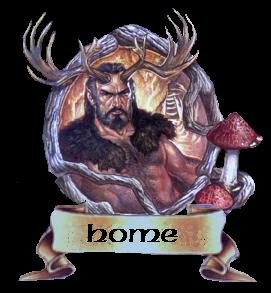|
circa
September 21
Also known as:
Autumn Equinox, Winter Finding (Teutonic), Alban Elfed (Caledonii)
Autumn
Equinox, around September 21, is the time of the descent of the
Goddess into the Underworld. With her departure, we see the
decline of nature and the coming of winter. This
is a classic, ancient mythos, seen the Sumerian myth of Inanna and
in the ancient Greek and Roman legends of Demeter and Persephone.
In
September, we also bid farewell to the Harvest Lord who was slain
at Lammas. He is the Green Man, seen as the cycle of nature
in the plant kingdom. He is harvested and his seeds are
planted into the Earth so that life may continue and be more
abundant.
Mabon
("Great Son") is a Welsh god. He was a great hunter with
a swift horse and a wonderful hound. He may have been a
mythologized actual leader. He was stolen from his mother, Modron (Great
Mother),when he was three nights old, but was eventually rescued
by King Arthur (other
legends say he was rescued by the Blackbird, the Stag, the Owl,
the Eagle, and the Salmon). All along, however, Mabon has been
dwelling, a happy captive, in Modron's magickal Otherworld --
Modron's womb. Only in this way can he be reborn. Mabon's light
has been drawn into the Earth, gathering strength and wisdom
enough to become a new seed. In this sense, Mabon is the masculine
counterpart of Persephone -- the male fertilizing principle
seasonally withdrawn. Modron corresponds with Demeter.
From
the moment of the September Equinox, the Sun's strength
diminishes, until the moment of the Winter Solstice in December,
when the Sun grows stronger and the days once again become longer
than the nights.
At
the Autumn Equinox, the days and nights are equal. It is a time of
balance, but light gives way to increased darkness.
It is the second harvest, and the Goddess mourns her fallen
consort, but the emphasis is on the message of rebirth that can be
found in the harvest seeds. It is a good time to walk the forests,
gathering dried plants for use as altar decorations or herbal
magick.
Cornbread and cider are good additions to festivities and
fall leaves make good altar decorations.
(Author
Anonymous)
|
Back
to top
~~o00o~~
The
Goddess is entering into crone-hood, and the dark of the
year is beginning, so this is a time often associated with
mysterious lore and wisdom. The altar and circle should be
decorated with autumn leaves, gourds, berries, pine and
cypress cones, acorns, oak sprigs and other fruits of the
season. New willow staves and wands were traditionally
consecrated or empowered on this day, so if you've just
recently cut one, you might want to bring it into the circle
with you. You should also have a small basket filled with a
variety of autumn leaves. The altar cloth shall be brown,
and the altar candles shall be red. Cast circle &
pick up the basket of leaves and hold it in both hands.
Spill the leaves slowly so that they cascade down to the
ground within the circle as you say these words: "The
days grow colder, and the leaves fall. Our Lord of the sun
rides the winds westward, and the cool, misty night
descends. Fruits ripen, and the seeds drop. This is a time
of balance, when night equals day, and though all seems dead
or dying, I know that life continues. Life is not possible
without death, and the coming of winter is just another
spoke in the great wheel."
Put
the basket down, and say: "Oh great Goddess of
the waning moon, keeper of the cauldron, of secret Magicks
and forgotten lore, teach me to be wise and peaceful in
thought and deed. Grant me your wisdom, and do not fear that
it may be used unwisely, or for purposes other than those
which encourage peace and prosperity."
Works
of Magick or activities may be performed now.
After any such things have been taken care of, hold
the simple feast, and then banish the sacred circle.
~~o00o~~
A
traditional practice is to walk wild places and forests,
gathering seed pods and dried plants. Some of these can
be used to decorate the home; others saved for future herbal
magic. The foods of Mabon consist of the second
harvest's gleanings, so grains, fruit and vegetables
predominate, especially corn. Corn bread is traditional
fare, as are beans and baked squash.
(excerpts from
Scott Cunningham's Wicca: A Guide for the Solitary
Practitioner)
|
|
Back
to top |
|



|
|
|